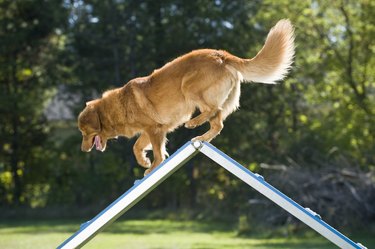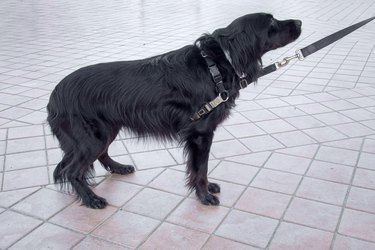No matter their shape, length, size or level of fluffiness, dog tails are an essential part of who they are. While we may acknowledge them flopping about, wagging in excitement, or occasionally knocking glasses off of our coffee tables, how much do we really know about our dog's tail? And what is it actually there for?
The truth is, dog tails serve a variety of purposes, more than most realize. And doggie life just wouldn't be the same without them.
Video of the Day
Video of the Day
Dogs use their tails to help with their more skillful moves.

Dogs' tails aren't just there for show, and they are very useful for dogs as they move around. Dogs tails often help them make complex or quick movements. For example, if a dog is running and needs to change direction quickly, you'll see a dog's tail helping with that movement.
Some dogs use their tails for balance.

Along with using their tails for complex movements, many dogs also use their tails for balance, though not all of them do. Many working dogs have been bred to use their tails for balance, because they may need it as a part of their job. In contrast, racing dogs like greyhounds have been bred with tails that help them balance while racing.
Dogs use their tails to communicate with us.
Dogs tails don't just exist for them, but for their humans, too. Dog tails are one of their most useful physical attributes in terms of getting humans to understand how the dog is feeling. A dog's tail has so many different emotions it can communicate, and we humans, even if we don't realize, very easily pick up on them.
Dogs use the position of their tail to indicate how they're feeling. Dogs have a neutral tail position, which can differ from dog to dog. When they hold their tail higher than normal, they might be feeling stimulated or interested in something. A lowered tail suggests submissiveness or caution. A tail pointing straight out usually indicates aggression.

One commonly known movement is when a dog holds his tail between his legs. We often understand this behavior as the sign of a frightened dog, but it can also indicate stress or worry or general anxiety. And be careful, because a dog that feels frightened and cornered can lash out aggressively, so always approach a dog with its tail tucked cautiously.
And of course, dogs wag their tails to communicate with us.
Probably the most universally well known tail behavior is the tail wag. At its most basic level, tail wag indicates a dog's excitement. As humans, we almost always read that excitement as being positive, but that isn't always the case. Tail wagging "excitement" can come in the form of unbridled enthusiasm, of course, but it can also indicate the high energy feelings associated with nervousness and aggression, too.
When a dog's tail wags in a higher position it may be happy excitement, but an extremely high position might be aggression. And wagging in a lowered position can indicate nervousness or submission. So rather than assuming that tail wagging always indicates positive emotions, we have to get to know our dog and their tail wag patterns to understand what mood their wags indicate.
The speed with which a dog wags their tail can also tell us more details about our pups' mood. A quick and clumsy wag usually indicates positive feelings and friendliness. Depending on the dog, these happy wags may come with butt or full body wiggles as well, indicating the dog's joy. A gentle wag might indicate that a pup feels nervous or tentative and a very fast, determined wag can indicate aggression.
Dogs also use their tails to communicate with each other.

According to a 2007 study, dogs' tail wagging actually indicates more than we realize. Dogs often wag their tails at high speeds as they approach each other, and their tails are communicating a lot in that early interaction. According to the study, dogs tend to wag their tails more to the right or more to the left to indicate their feelings. A right-leaning tail wag indicates positive emotions, while a left-leaning tail wag suggests negative emotions. In a quick two dog interaction say on a walk or at the dog park, humans might not pick up on these subtleties of puppy communication. But dogs understand it.
Another study found that dogs understood each other's asymmetrical tail wagging and responded to the positive or negative emotions accordingly. So even if their humans aren't totally up on doggie tail wagging lingo, between dogs the signals are pretty clear.
Dogs even use their tails to help spread their scent the way they want.

Dogs' tails are located close to the anus, and around their anus, dogs have anal glands that contain scents they use to mark their territory and generally proclaim their presence to the doggie world. Wagging their tails helps to contract the muscles around the anal glands and spread their scent. Highly confident dogs who want to spread their scent far and wide often hold their tails higher, so they're dispersing their scent more freely. Submissive dogs tend to hold their tails lower, so they can release their scent more cautiously.
Conclusion
Dogs' tails serve many purposes, including balance, scent spreading, and communication with humans and other dogs. Though certain tail positions and movements have general meanings, different dogs may communicate them differently, and what's true for one dog may not be true for another. Get to know your dog to learn what all their different tail movements really mean!
Always check with your veterinarian before changing your pet’s diet, medication, or physical activity routines. This information is not a substitute for a vet’s opinion.
